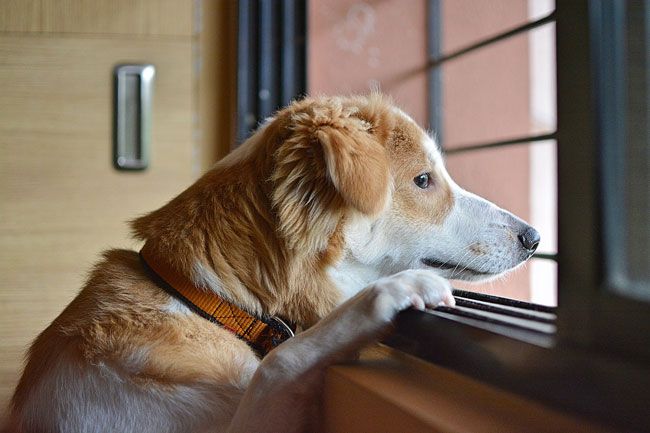Those of us who have long shared our lives with non-human animal companions know all too well that, in the end, the joy they bring to our world is tempered by the impossible, unbearable pain of loss when they leave this earth. Our canine and feline companions tend to live between 10 and 20 years – never long enough.
We know, of course, when we adopt a new animal companion into our family, that there will a day when we have to say good-bye, but the oxytocin rush of our new love causes the awareness of that knowledge to dim. Until one day, there it is. The inevitable. Time to say good-bye. Time to cry.
During my 20 years at the Marin Humane Society, it was a frequent occurrence for me and other staff members to comfort and commiserate with owners who brought their beloved companions to us for euthanasia. We often cried with them – and we always assured them that it was okay for them to cry, too. We also cried for the ones who were ownerless, who had no options, and for whom we provided caring, gentle deaths in the euthanasia room.
In addition to my animal-shelter work, I have had the joy and privilege of sharing my heart with more than 80 of my own animal companions across my lifetime, including dogs, cats, horses, goats, a sheep, a pig, and a host of small companions – mice, rabbits, and birds. Many tears have been shed over those years. Most recently, we said good-bye to our Lucy.
My Most Recent Loss
Lucy was 14. Many of you have followed her exploits over the years in my WDJ articles, from her feisty, vocal, Cardigan Corgi adolescence when we adopted her at the age of six months, through her resource-guarding conflicts with our other canine family members, her sound sensitivity, her separation distress, and more.
We knew Lucy was slowing down in recent years. She stopped jumping up on the bed a couple of years ago, and in the past year declined to jump up on the sofa except for rare occasions. She no longer chased the water droplets when we emptied horse buckets in the arena, and she declined to chase sticks on our hikes around the farm. We did her annual well-pet checkups every year. She still seemed alert, ruled the canine members of the household, and willingly assisted as a neutral dog for client consults and for our Reactive Rover workshops.
In mid January, though, she started vomiting and developed diarrhea over a weekend, and she had no interest in eating. The vet’s exam on Monday found a tumor in her vulva – probably metastasized from elsewhere in her body. Lucy had well-advanced cancer. The vet gave her injections of pain medication, antibiotics, and an anti-inflammatory, and said, “We’ll see.” But the next morning, Lucy couldn’t even stand. We called the hospital to let them know we were coming in and prepared ourselves to say good-bye. It was Tuesday, January 16, her 14th birthday. With hugs and tears, as Lucy lay on the exam room floor, we held her and watched as our vet delivered the euthanasia solution and give her the gentle death that she deserved. And we all cried.
The Five Stages of Grieving for Pets
I am now, still, grieving our sudden loss of Lucy, as well the unexpected death of our pot-bellied pig, Sturgis, just one week before that. It’s hard – very hard – even though I’m familiar with and understand the stages of grief.
The “five stages of grief” were first identified by Swiss-born Dr. Elisabeth Kubler-Ross in her book, On Death and Dying, published in 1969. Initially relating to awareness of one’s own pending death, over the years, the concepts have been applied by health care professionals to anyone suffering the loss of something of vital importance. Of course, we know that includes the loss of beloved animal companions.
Not everyone experiences all five stages of grief, and the stages may be experienced in a variable order. Grieving is a very individual process. Often, however, the first reaction to grief is denial.
1. Denial
This reaction frequently occurs when you first receive the diagnosis of a terminal illness or injury, while your animal companion is still alive. The more sudden the impending death, the harder it may be to accept, because you have had little or no time to prepare. You refuse to believe your veterinarian is correct. There must be some medical advance or alternative treatment that will fix this. Indeed, there are legions of anecdotes about terminally ill pets who have been miraculously cured by natural therapies when their lives had been written off by Western medicine.
Eventually, however, unless you are one of the rare, fortunate few, the diagnosis becomes a reality, and you can no longer deny that your companion is gone – or soon will be.
2. Anger/Blame/Guilt
Rational or not, you may be angry that your companion is dying; angry that your veterinarian can’t save her; angry at the driver of the car that hit her; angry at yourself for letting her slip out… This, too is normal.
Guilt is self-blame. Sometimes your guilt has a rational basis. Perhaps you are the one who let your dog slip out the front door and then she got hit by a car. Sometimes, despite knowing you have provided the best care you could for your companion, you still feel guilty that she had developed cancer. If only you had fed her a better quality diet for her entire life, instead of just the past five years. If only you had taken her to the vet hospital sooner when you noticed she wasn’t quite right, instead of waiting a few days…
If you must make the difficult decision to have your dog euthanized, your guilt may be compounded by the fact that you are choosing to end her life. Even though you know that she is suffering, and that euthanasia is the final act of kindness after a lifetime of kindnesses, it can be hard to get beyond the moral sense that taking her life is wrong. You are killing your dog. It does no good for people to tell you not to feel guilty – you will feel what you feel, and it is a perfectly appropriate and normal part of the grieving process.
3. Bargaining
At some point during your grief you may try bargaining. If you promise to go to church every Sunday for the rest of your life, maybe God will let her live. If you commit to volunteering at your local animal shelter, maybe your dog who has been missing for two months will miraculously appear in a kennel at the shelter. In any case, when you finally begin to accept the reality of your loss, you may become depressed.
4. Depression
This is a time when you intensely experience the sadness of your loss, and feel hopeless and helpless to recover. You may cry, withdraw, stop eating, or not want to get out of bed. Daily tasks may seem impossible. Some people may feel there is no reason to go on with their lives, and may even become suicidal. Professional assistance can be invaluable for someone who is having difficulty with this stage.
5. Acceptance
This is the final stage of the grieving process. When you can accept the loss of your companion, you are ready to begin your return to normal functioning. You will still feel pain and sadness, and there may be times when feelings of anger, guilt, blame, and depression reappear, but they will likely return with less intensity.
In time, they will increasingly be replaced with happy memories of the times you and your dog spent together. The sadness may never go away completely, but it will become more bearable.
A Visualization Exercise for Grieving
When I was in sheltering work, we paid a lot of attention to grief counseling, and to compassion fatigue for our shelter staff. At some point I came across this lovely visualization exercise, which I find very comforting in times of loss. I regret I don’t remember the source, and hope I do it justice:
In a quiet darkened room with gentle music and soft lighting, perhaps candles, make yourself comfortable on soft cushions, breathe, and relax. Close your eyes, and imagine yourself in a peaceful place – perhaps a sunny meadow, or a quiet wood next to a trickling stream. Breathe.
Now imagine your dog appearing at the edge of the meadow and running happily to you. You greet her joyfully, and the two of you spend many minutes together, remembering
happy times together.
When it’s time to go, you reach down and put your hands against her sides. As you watch, she becomes smaller and smaller, until she is small enough that you can pick her up, cupped in your hands. Now pick her up, hold her in your hands, and place her in your heart, where she will stay with you, forever.
It’s Okay to Cry
It’s important to remember that grieving is normal, natural and healthy. It’s okay to cry, scream, yell, get angry, and be depressed and sad, as long as you aren’t harming yourself or anyone else. If at any time you feel overwhelmed and unable to cope, or feel that you are “stuck” in one of the stages, you can seek help from pet-loss hotlines, grief counselors, and other health professionals who specialize in helping people through the grief process.
Rituals can help you move along the difficult path of grieving. Memorial services including burials or scattering of ashes, donations in your dog’s name, an announcement in the newspaper, and other similar activities can help diffuse the pain of your loss. Lucy is buried on our farm, next to one of the Christmas trees that she loved to help us plant every year after the holidays. Bonnie and Kai, our remaining two dogs, were in attendance for the ceremony.
I still cry for Lucy. I also wonder whether we should have noticed, sooner, that her appetite wasn’t as sharp as it used to be. That the sparkle in her eyes was gone.
The tears slide down my cheeks as I dump water buckets in the arena and envision her happily dashing after the droplets … as I take hikes around the farm with Bonnie and Kai, and desperately miss Lucy’s stick-chasing enthusiasm … as I remove clothes from the dryer and she’s not there on sentry duty to snatch up any overlooked treats that fall out of the pockets … As I fix the dogs’ dinner and only fill two bowls instead of three, I remind myself that it’s okay to cry.
Grief Resources for Losing a Pet
There are many resources available to those who are struggling with the loss of a beloved animal companion. Here are a few of our favorites:
Books
Pet Loss: A Thoughtful Guide for Adults and Children, by Herbert A Nieburg and Arlene Fischer
I Heard Your Dog Died: Imaginings for Those Who Have Lost a Pet, by Bonnie Kreitler
The Loss of a Pet: A Guide to Coping with the Grieving Process When a Pet Dies, by Wallace Sife
Coping With Sorrow on the Loss of Your Pet, by Moira Anderson Allen
Support Groups
The Association for Pet Loss and Bereavement
Pet Loss Support Hotline; Cummings School of Veterinary Medicine
Pet Loss Support Hotline, College of Veterinary Medicine, Washington State University
Facebook Groups
Pet Loss Grief and Terminal Illness Support Group
Rainbow Bridge Pet Loss Grief and Support
Author Pat Miller, CBCC-KA, CPDT-KA, is WDJ’s Training Editor. She and her husband Paul live in Fairplay, Maryland, site of her Peaceable Paws training center. Miller is also the author of many books on positive training. Her newest is Beware of the Dog: Positive Solutions for Aggressive Behavior in Dogs.






